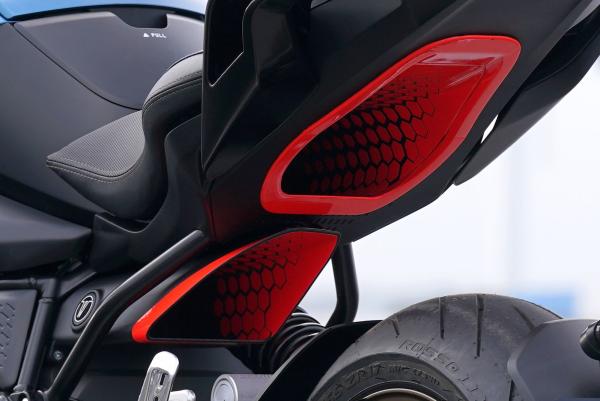The elephant in the room this year has been electric Bikes, and trying to fathom precisely how they will fit into the two-wheeled landscape.
Sure, lightweight 125cc equivalent city bikes are selling well, and companies like Maeving and the recently announced Flying Flea brand, itself an offshoot of Royal Enfield, show that battery-powered urban mobility solutions seem to have a home within the landscape.
Backing this up are sales figures from the MCIA, which shows that in 2023 a total of 4,062 electric machines were registered in the UK. Of that total 3,718 machines fall into the sub-11kW segment, making them 125cc equivalent or below. Of those bikes, 1,762 were classed as having an output of under 4kW, making them equivalent to a 50cc petrol-powered moped.
Now, those numbers aren’t enough to sustain a two-wheeled industry alone, and they are crushed by the 109,527 petrol-powered machines sold in 2023. Cast your eye further down the registration data though, and the numbers start to look much more stark. In 2023 just 69 sub-35kW (47bhp) bikes were shifted, and above that, only 58 bikes were registered in the over 35kW segment. These bikes, which include the LiveWire S2 Del Mar and Mulholland, and a number of bikes from the Zero brand, are the ones proving to be a much harder sell in the current climate.
While the sales of lightweight electric bikes go some way to proving that there is an appetite for cost-effective urban mobility solutions, an uncertainty around electric bikes seems to be preventing people from stumping up significant chunks of cash for them.
And it’s not just the old arguments of range, recharge times, and charging infrastructure that are hurting the sales, although they are still factors. Depreciation is also an issue, and just a quick search on the internet pulls up a 2021 Zero SR/F with a shade over 19,000 miles on the clock, listed for sale at £8,495. That’s a drop of more than £11,00 from the circa £20,000 price tag the bike would have had when new. For most sensible people that represents second-hand residual value that isn’t worth investing in.
Moreover, the UK government has in recent years reduced its help for those looking to take the plunge into the electric sector, and currently only vehicles priced at less than £10,000 are eligible for the £500 electric plug-in grant. That means bikes like Kawasaki’s £7,100 Z e-1 and £7,699 Ninja e-1 are eligible, while bikes like the aforementioned Zeroes and LiveWires are not.
And it’s not just the lack of financial help to electric bikes that is making life hard, because the current labour government makes no secret of the fact that it has no policy to increase the uptake and usage of powered two-wheelers, battery-powered or otherwise. Instead, it’s looking to increase the number of journeys we take on foot or on bicycles.
Highlighting this blinkered view of the world from within Whitehall were the comments the Labour government made relating to the denial of UK-wide motorcycle bus lane use access. “At present, the government has no policy to encourage greater use of motorcycles” the statement reads, adding, “The existing position, that local authorities can allow motorcycles into bus lanes at their discretion, aligns with wider government policy on bus service improvements, encouraging walking and cycling and devolving powers to local authorities.”
So where does this leave the flailing UK and European electric bike industry? Grasping at straws seems to be the case. With every news story that comes about telling us of another battery bike maker going belly up, Energica and Cake being two notable names in 2024, those companies that remain will desperately fire out hot deals on new bikes as they try and tempt riders away from the warm and fuzzy glow of the internal combustion engine.
And then we come to the bike you see at the top of this page, a special prototype that was created by White Motorcycle Concepts (WMC). WMC is a specialist company, which focuses on increasing the efficiency of bikes through engine tuning, suspension upgrades and, as is the case here, with aerodynamics.
It is WMC’s first production bike that utilises an innovative ducting system, that effectively cuts a hole in the centreline of the bike to allow for less drag, and therefore improved range and a higher top speed. It’s a concept that we first saw on WMC250EV, a wild-looking speed record contender, touted as being good for topping the magic 250mph.
The result of the ducting is a nominal 10 per cent reduction in overall drag, which on the face of it seems like a win, although dig a bit deeper into the numbers and it starts to look slightly less promising. The 10 per cent reduction in drag only equates to a claimed nine per cent increase in range at highway speeds. In real terms that means that all that R&D, computational fluid dynamics, and more than 39 prototype ducts have added just over 10 miles to the bike’s claimed maximum mileage.
Granted, the bike in question is a prototype built in collaboration with a specialist company, but when the biggest electric bike maker in the game wants to get in on this sort of exercise, you do have to ask yourself when the battery-powered bubble will burst. And more importantly, when will governments and legislators start to look at the other, far more viable alternatives to battery power and petrol, such as synthetic fuels?




